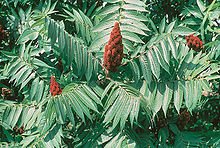Rhus typhina
Rhus typhina | |
|---|---|
 | |
Scientific classification | |
| Kingdom: | Plantae |
Clade: | Angiosperms |
Clade: | Eudicots |
Clade: | Rosids |
| Order: | Sapindales |
| Family: | Anacardiaceae |
| Genus: | Rhus |
| Species: | R. typhina |
Binomial name | |
Rhus typhina L. | |
 | |
Synonyms | |
Rhus hirta | |
Rhus typhina, the staghorn sumac,[1] is a species of flowering plant in the family Anacardiaceae, native to eastern North America. It is primarily found in southeastern Canada, the northeastern and midwestern United States and the Appalachian Mountains,[2] but is widely cultivated as an ornamental throughout the temperate world.
Contents
1 Etymology
2 Description
3 Cultivation
4 Other uses
5 References
6 External links
Etymology
The specific epithet typhina is explained in Linnaeus's and Ericus Torner's description of the plant with the phrase "Ramis hirtis uti typhi cervini" meaning "the branches are rough like antlers in velvet".[3]
Description

Male flower at early stage of blooming
Rhus typhina is a dioecious, deciduous shrub or small tree growing up to 5 m (16 ft) tall by 6 m (20 ft) broad. It has alternate, pinnately compound leaves 25–55 cm (10–22 in) long, each with 9–31 serrate leaflets 6–11 cm (2 1⁄4–4 1⁄4 in) long.[4] Leaf petioles and stems are densely covered in rust-colored hairs. The velvety texture and the forking pattern of the branches, reminiscent of antlers, have led to the common name "stag's horn sumac".[5] Staghorn sumac grows as female or male clones.[6]
Small, greenish-white though yellowish flowers occur in dense terminal panicles, and small, green through reddish drupes occur in dense infructescences. [4] Flowers occur from May through July and fruit ripens from June through September in this species’ native range.[7] Infructescences are 10–20 cm (4–8 in) long and 4–6 cm (1 1⁄2–2 1⁄4 in) broad at their bases. Fall foliage is brilliant shades of red, orange and yellow.[5] Fruit can remain on plants from late summer through spring.
Staghorn sumac spreads by seeds and rhizomes and forms clones often with the older shoots in the center and younger shoots around central older ones.[4] Large clones can grow from octets[clarification needed] in several years.
Within Anacardiaceae, staghorn sumac is not closely related to poison sumac (Toxicodendron vernix), although they share the name "sumac."
In late summer some shoots have galls on leaf undersides, caused by the sumac leaf gall aphid, Melaphis rhois. The galls are not markedly harmful to the tree.
Cultivation
Staghorn sumac is an ornamental plant which provides interest throughout the year; though its vigorous, suckering habit makes it unsuitable for smaller gardens. It can grow under a wide array of conditions, but is most often found in dry and poor soil on which other plants cannot survive.[4] Some landscapers remove all but the top branches to create a "crown" effect in order to resemble a small palm tree. Numerous cultivars have been developed for garden use, of which 'Dissecta' syn. 'Laciniata' (cutleaf staghorn sumac) has gained the Royal Horticultural Society’s Award of Garden Merit.[8][9]
In both French and German, the common name of the species (sumac vinaigrier, Essigbaum) means "vinegar tree".
Other uses

Gall on R. typhina caused by the aphid Melaphis rhois
Some beekeepers use dried sumac bobs as a source of fuel for their smokers.
The fruit of sumacs can be collected, soaked and washed in cold water, strained, sweetened and made into a pink "lemonade" sometimes called "Indian lemonade".[10] The leaves and berries of staghorn sumac have been mixed with tobacco and other herbs and smoked by Native American tribes.[11] This practice continues to a small degree to this day.
All parts of the staghorn sumac, except the roots, can be used as both a natural dye and as a mordant. The plant is rich in tannins and can be added to other dye baths to improve light fastness. The leaves may be harvested in the summer and the bark all year round.[12]
References
^ "Rhus typhina". Natural Resources Conservation Service PLANTS Database. USDA. Retrieved 21 October 2015..mw-parser-output cite.citation{font-style:inherit}.mw-parser-output q{quotes:"""""""'""'"}.mw-parser-output code.cs1-code{color:inherit;background:inherit;border:inherit;padding:inherit}.mw-parser-output .cs1-lock-free a{background:url("//upload.wikimedia.org/wikipedia/commons/thumb/6/65/Lock-green.svg/9px-Lock-green.svg.png")no-repeat;background-position:right .1em center}.mw-parser-output .cs1-lock-limited a,.mw-parser-output .cs1-lock-registration a{background:url("//upload.wikimedia.org/wikipedia/commons/thumb/d/d6/Lock-gray-alt-2.svg/9px-Lock-gray-alt-2.svg.png")no-repeat;background-position:right .1em center}.mw-parser-output .cs1-lock-subscription a{background:url("//upload.wikimedia.org/wikipedia/commons/thumb/a/aa/Lock-red-alt-2.svg/9px-Lock-red-alt-2.svg.png")no-repeat;background-position:right .1em center}.mw-parser-output .cs1-subscription,.mw-parser-output .cs1-registration{color:#555}.mw-parser-output .cs1-subscription span,.mw-parser-output .cs1-registration span{border-bottom:1px dotted;cursor:help}.mw-parser-output .cs1-hidden-error{display:none;font-size:100%}.mw-parser-output .cs1-visible-error{font-size:100%}.mw-parser-output .cs1-subscription,.mw-parser-output .cs1-registration,.mw-parser-output .cs1-format{font-size:95%}.mw-parser-output .cs1-kern-left,.mw-parser-output .cs1-kern-wl-left{padding-left:0.2em}.mw-parser-output .cs1-kern-right,.mw-parser-output .cs1-kern-wl-right{padding-right:0.2em}
^ "Rhus typhina Range Map" (PDF). United States Geological Survey. Archived from the original (PDF) on 2012-06-26. Retrieved 2008-03-02.
^ Linnaeus, Carl; et al. (1756). Centuria II plantarum. p. 14.
^ abcd Uva, Richard H.; Neal, Joseph C.; Ditomaso, Joseph M. (1997). Weeds of The Northeast. Ithaca, NY: Cornell University Press. pp. 326–327. ISBN 0-8014-3391-6.
^ ab RHS A-Z encyclopedia of garden plants. United Kingdom: Dorling Kindersley. 2008. p. 1136. ISBN 1405332964.
^ Sullivan, Janet (1994). "Rhus typhina". Fire Effects Information System (FEIS). US Department of Agriculture (USDA), Forest Service (USFS), Rocky Mountain Research Station, Fire Sciences Laboratory – via https://www.feis-crs.org/feis/.
^ "Rhus" (PDF). Woody Plant Seed Manual. USDA Forest Service.
^ "RHS Plantfinder - Rhus typhina 'Dissecta'". Retrieved 9 October 2018.
^ "AGM Plants - Ornamental" (PDF). Royal Horticultural Society. July 2017. p. 87. Retrieved 9 October 2018.
^ Peterson, Lee Allen (1977). Edible Wild Plants. New York: Houghton Mifflin. p. 186. ISBN 0-395-20445-3.
^ "Smoking and Pipes". Traditional Lifestyle. Cowasuck Band of the Pennacook-Abenaki People.
^ Dean, Jenny (1999). Wild Color: The Complete Guide to Making and Using Natural Dyes. New York: Watson-Guptill. p. 123.
External links
Wikispecies has information related to Rhus typhina |
| Wikimedia Commons has media related to Rhus typhina. |
"Rhus typhina". Germplasm Resources Information Network (GRIN). Agricultural Research Service (ARS), United States Department of Agriculture (USDA).
- Bioimages: Rhus typhina (as R. hirta).
- Missouri Plants
- North Woods wiki. Rhus typhina.
- Brian Johnston. A Close-up View of the Staghorn Sumac (Rhus typhina). Microscopy—UK.